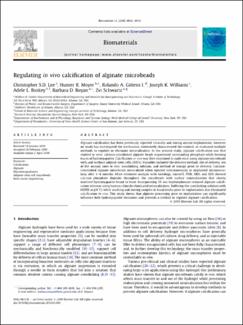| dc.contributor.author | S.D. Lee, Christopher | |
| dc.contributor.author | Moyer, Hunter R. | |
| dc.contributor.author | Gittens I, Rolando A. | |
| dc.contributor.author | Williams, Joseph K. | |
| dc.contributor.author | Boskey, Adele L. | |
| dc.contributor.author | Boyan, Barbara D. | |
| dc.contributor.author | Schwartz, Zvi | |
| dc.date.accessioned | 2020-07-24T01:55:16Z | |
| dc.date.available | 2020-07-24T01:55:16Z | |
| dc.date.issued | 2010-04-02 | |
| dc.identifier.other | doi.org/10.1016/j.biomaterials.2010.03.001 | |
| dc.identifier.uri | http://repositorio-indicasat.org.pa/handle/123456789/215 | |
| dc.description | Alginate calcification has been previously reported clinically and during animal implantation; however no study has investigated the mechanism, extensively characterized the mineral, or evaluated multiple methods to regulate or eliminate mineralization. In the present study, alginate calcification was first studied in vitro: calcium-crosslinked alginate beads sequestered surrounding phosphate while forming traces of hydroxyapatite. Calcification in vivo was then examined in nude mice using alginate microbeads with and without adipose stem cells (ASCs). Variables included the delivery method, site of delivery, sex of the animal, time in vivo, crosslinking solution, and method of storage prior to delivery. Calciumcrosslinked alginate microbeads mineralized when injected subcutaneously or implanted intramuscularly after 1e6 months. More extensive analysis with histology, microCT, FTIR, XRD, and EDS showed calcium phosphate deposits throughout the microbeads with surface mineralization that closely matched hydroxyapatite found in bone. Incorporating 25 mM bisphosphonate reduced alginate calcification whereas using barium chloride eliminated mineralization. Buffering the crosslinking solution with HEPES at pH 7.3 while washing and storing samples in basal media prior to implantation also eliminated calcification in vivo. This study shows that alginate processing prior to implantation can significantly influence bulk hydroxyapatite formation and presents a method to regulate alginate calcification | en_US |
| dc.description.abstract | Alginate calcification has been previously reported clinically and during animal implantation; however no study has investigated the mechanism, extensively characterized the mineral, or evaluated multiple methods to regulate or eliminate mineralization. In the present study, alginate calcification was first studied in vitro: calcium-crosslinked alginate beads sequestered surrounding phosphate while forming traces of hydroxyapatite. Calcification in vivo was then examined in nude mice using alginate microbeads with and without adipose stem cells (ASCs). Variables included the delivery method, site of delivery, sex of the animal, time in vivo, crosslinking solution, and method of storage prior to delivery. Calciumcrosslinked alginate microbeads mineralized when injected subcutaneously or implanted intramuscularly after 1e6 months. More extensive analysis with histology, microCT, FTIR, XRD, and EDS showed calcium phosphate deposits throughout the microbeads with surface mineralization that closely matched hydroxyapatite found in bone. Incorporating 25 mM bisphosphonate reduced alginate calcification whereas using barium chloride eliminated mineralization. Buffering the crosslinking solution with HEPES at pH 7.3 while washing and storing samples in basal media prior to implantation also eliminated calcification in vivo. This study shows that alginate processing prior to implantation can significantly influence bulk hydroxyapatite formation and presents a method to regulate alginate calcification | en_US |
| dc.format | application/pdf | |
| dc.language.iso | eng | en_US |
| dc.rights | Info:eu-repo/semantics/openAccess | |
| dc.rights | https://creativecommons.org/licenses/by/4.0/deed.es | |
| dc.subject | Calcification Alginate | en_US |
| dc.subject | Microencapsulation Adipose | en_US |
| dc.subject | stem cell microbeads | en_US |
| dc.subject | Bone tissue engineering | en_US |
| dc.title | Regulating in vivo calcification of alginate microbeads | en_US |
| dc.type | info:eu-repo/semantics/article | en_US |
| dc.type | Info:eu-repo/semantics/publishedversion | |

